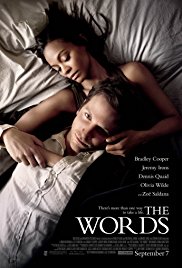THE WORDS
SUBJECTS — Literature;
SOCIAL-EMOTIONAL LEARNING — Ambition, Romantic Relationships, Work/Career;
MORAL-ETHICAL EMPHASIS — Trustworthiness.
AGE: 15+; MPAA Rating: PG 13;
2012; 102 Minutes; Color. Available from Amazon.com.
There is NO AI content on this website. All content on TeachWithMovies.org has been written by human beings.

SUBJECTS — Literature;
SOCIAL-EMOTIONAL LEARNING — Ambition, Romantic Relationships, Work/Career;
MORAL-ETHICAL EMPHASIS — Trustworthiness.
AGE: 15+; MPAA Rating: PG 13;
2012; 102 Minutes; Color. Available from Amazon.com.
TWM offers the following worksheets to keep students’ minds on the movie and direct them to the lessons that can be learned from the film.
Film Study Worksheet for ELA Classes;
Film Study Worksheet for Adaptations of Novels;
and
Worksheet for Cinematic and Theatrical Elements and Their Effects.
Teachers can modify the movie worksheets to fit the needs of each class. See also TWM’s Movies as Literature Homework Project and Historical Fiction in Film Cross-Curricular Homework Project.
A struggling young writer receives a used brief case as a present. Hidden inside is a manuscript which he publishes under his own name. It is a smash best-seller and establishes him as an up-and-coming young writer. The lie eventually ruins his marriage to the only woman he will ever love. Later, he is confronted by the real author.
Selected Awards: None.
Cast: Bradley Cooper, Zoe Saldana, Dennis Quaid, John Hannah, and Jeremy Irons.
Director: Brian Klugman, Lee Sternthal.
Students will benefit from a sophisticated and interesting look at the psychological consequences of cheating when the rewards have been great and the plagiarism has remained undiscovered.
Through class discussion, writing and research assignments, students will improve their standards-based skills as they reflect on the story and the tremendous personal costs suffered by the protagonist for his act of plagiarism.

There are some images of sexuality.
This film may provide an opportunity for parents to discuss the consequences of cheating, an important topic for school-aged children.

The kernel of the story hearkens back to the experience of Ernest Hemingway whose first wife, in 1922, lost a briefcase with virtually all of his early work in it, including the carbon copies. The briefcase was never recovered and almost all of Hemingway’s early work was lost. The plot of The Words does not appear to take the Hemingway connection any further than the similarity in these sets of circumstances.
1. What did Rory’s plagiarism cost him?
Suggested Response:
There were a number of things. They included his marriage and the love his wife had for him and as well as large elements of his self-respect.
2. Since it is clear that the real author of the book did not want fame or money from his lost manuscript, what appears to be the purpose behind his confrontation with Rory?
Suggested Response:
Answers will vary and all soundly presented thoughts are acceptable. Students may note that the old man simply wanted to be known to Rory and he wanted the plagiarizer to understand the pain associated with the theft of someone else’s words.
3. In what way is cheating on a test or on an essay assignment in the classroom similar to the cheating done by Rory in this story? How are they different?
Suggested Response:
Students should note that any presentation of information, feelings or art that does not belong to the individual doing the presenting is a form of lying. It is unethical and robs the cheater of his own voice so that he is seen as someone he is not. Differences between cheating on a test and plagiarism in a published work include that the tests are imposed by the outside world and the consequences are different. Another difference may be that some peer groups find cheating acceptable, while among the community of writers, plagiarism is a great sin.
4. Is there anything that Rory could have done to redeem himself? What were they? Did they include writing an alleged “novel” about what he did and what happened to him as a result but not admitting that it was autobiographical.
Suggested Response:
Certainly, redemption was possible. Rory could have publicly admitted his plagiarism and given all money he made on the book to the old man or if it was before the old man appeared, to a charity. Since Rory wanted to continue to write, it might have been better to try it under a pseudonym. A strong argument could be made that publishing the novel about the plagiarism, but not admitting that it was autobiographical, was not redemption but just another cynical use of the plagiarism.
5. What prevents Rory from revealing the truth to his wife when she first reads the manuscript?
Suggested Response:
Students may determine that Rory longs to be a successful author and does not want his wife to see him as the failed artist he sees himself to be. Some may think he lacks courage or that he loves her too much to abide disappointing her.
See Discussion Questions for Use With any Film that is a Work of Fiction.
See Discussion Questions #s 1 and 4 in the Learning Guide.
1. How could Rory have admitted his plagiarism and continued to write?
Suggested Response:
It would have been difficult. He would have had to submit manuscripts under a pseudonym. However, he could also have given up writing and chosen another career. It would have hurt, but he might have been able to salvage his self-respect and his marriage.
See Discussion Question # 1 in the Learning Guide.
2. Why did Rory’s plagiarism and the refusal to admit it and give up its benefits poison his marriage?
Suggested Response:
It made his wife feel complicit any time she spent the money he earned or watched him accept accolades for writing the book. It wasn’t a matter of not being able to forgive him, it was that the plagiarism was an ongoing false statement.
(Be honest; Don’t deceive, cheat or steal; Be reliable — do what you say you’ll do; Have the courage to do the right thing; Build a good reputation; Be loyal — stand by your family, friends and country)
See Discussion Questions #s 1, 3 & 4 in the Learning Guide.
See also Discussion Questions which Explore Ethical Issues Raised by Any Film.
Most of the discussion questions in this Guide and in the Supplemental Materials can serve as writing prompts. Additional assignments include:
1. Ralph Waldo Emerson said that “Envy is ignorance, Imitation is suicide.” Cheating can be seen as a form of both envy and imitation; one is pretending to be someone capable of the work presented as his or her own. Write an informal essay in which you consider Emerson’s words in terms of the kind of cheating shown in the film. Who is being envied? Who is being imitated? What are the costs Rory pays over his lifetime for the theft of another man’s words?
2. Write an analytical essay on the use of a frame narrative to tell the story in the film. Detail the organization of the frame in terms of when the flashbacks begin and when they return to the ongoing events. Evaluate the technique in terms of its ability to tell the three stories that are presented and conclude your essay with a qualitative judgment on the technique used. To complete this assignment, you will need to watch the film at least one more time.
3. Research and write a formal investigation on cheating as it relates to education. Include in your essay the definitions of cheating, the statistics on the occurrence of cheating at both lower and higher education and the reasons given by cheaters to not only commit their fraud but to justify it. You may want to create a survey of students at your school that will reinforce or counter the claims you have found in your research. Conclude your essay with suggestions about how the problem of cheating can be diminished.
See also Additional Assignments for Use With any Film that is a Work of Fiction.
Multimedia: Anchor Standard #7 for Reading (for both ELA classes and for History/Social Studies, Science, and Technical Classes). (The three Anchor Standards read: “Integrate and evaluate content presented in diverse media, including visually and quantitatively as well as in words.”) CCSS pp. 35 & 60. See also Anchor Standard # 2 for ELA Speaking and Listening, CCSS pg. 48.
Reading: Anchor Standards #s 1, 2, 7 and 8 for Reading and related standards (for both ELA classes and for History/Social Studies, Science, and Technical Classes). CCSS pp. 35 & 60.
Writing: Anchor Standards #s 1 – 5 and 7- 10 for Writing and related standards (for both ELA classes and for History/Social Studies, Science, and Technical Classes). CCSS pp. 41 & 63.
Speaking and Listening: Anchor Standards #s 1 – 3 (for ELA classes). CCSS pg. 48.
Not all assignments reach all Anchor Standards. Teachers are encouraged to review the specific standards to make sure that over the term all standards are met.
This Learning Guide was written by James Frieden and Mary RedClay.
This Guide was published on September 3, 2013.